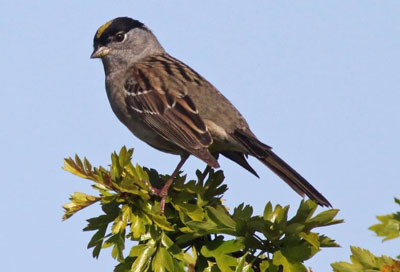
The Golden-Crowned Sparrow, one of the 53 species of birds tested in the UC Berkeley study and a common sight in suburban areas, was revealed to be an important host of the Lyme Disease-causing bacteria Borrelia burgdorferi. (Michael McCloy photo)
Birds are more important than previously recognized as hosts for Lyme disease-causing bacteria in California, according to a new study led by UC Berkeley researchers.
The findings, published Feb. 25 in the journal PLOS ONE, shine a light on an important new reservoir in the western United States for the corkscrew-shaped bacterium, Borrelia burgdorferi, responsible for Lyme disease. Wood rats, western gray squirrels and other small mammals have been identified in previous studies as wildlife hosts of the Lyme disease spirochete bacterium in California, but fewer studies have looked at the role of birds as reservoirs.
“The role of birds in the maintenance of Lyme disease bacteria in California is poorly understood,” said study lead author Erica Newman, a UC Berkeley Ph.D. student in the Energy and Resources Group and the Department of Environmental Science, Policy and Management. “This is the most extensive study of the role of birds in Lyme disease ecology in the western United States, and the first to consider the diversity of bird species, their behaviors and their habitats in identifying which birds are truly the most important as carriers.”
Moreover, the birds in the study that were found to be important hosts of Lyme disease bacteria, such as American robins, dark-eyed juncos and golden-crowned sparrows, are coincidentally ones that are commonly found in suburban environments.
According to the Centers for Disease Control and Prevention, Lyme disease is the most commonly reported tick-borne illness in the United States.
